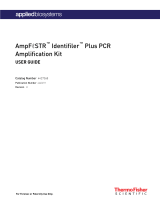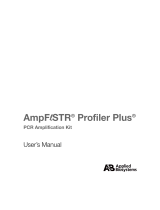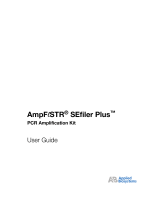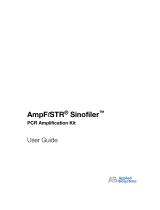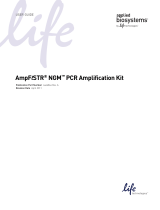Page is loading ...

AB Confidential: For Internal Distribution Only
February 7, 2003 11:24 am, 4341742.fm
User Bulletin
ABI PRISM® 310 Genetic Analyzer
February 7, 2003
SUBJECT: Protocols for Processing AmpFlSTR® PCR
Amplification Kit Products with the Microsoft®
Windows NT® Operating System
In This User
Bulletin
Dedicated Equipment and Supplies. . . . . . . . . . . . . . . . . . . . . . . . . . 4
Safety. . . . . . . . . . . . . . . . . . . . . . . . . . . . . . . . . . . . . . . . . . . . . . . . . 9
Matrix File Creation . . . . . . . . . . . . . . . . . . . . . . . . . . . . . . . . . . . . 13
Instrument Setup . . . . . . . . . . . . . . . . . . . . . . . . . . . . . . . . . . . . . . . 20
Electrophoresis . . . . . . . . . . . . . . . . . . . . . . . . . . . . . . . . . . . . . . . . 26
Data Analysis . . . . . . . . . . . . . . . . . . . . . . . . . . . . . . . . . . . . . . . . . 29
Before You Begin
Applicable
AmpFlSTR Kits
PCR products generated from any of the AmpFlSTR kits may be
used with the protocols described in this user bulletin.
Software
Requirements
The protocols in this user bulletin require the following software and
files to be installed on your computer:
• Microsoft Windows NT operating system
• 310 Data Collection Software v3.0 (PN 4326986)
•ABIP
RISM® GeneScan® Analysis Software v3.7.1
•ABIP
RISM® Genotyper® Software v3.7
• Appropriate run module file
– GS STR POP4 (1 mL) G5v2 module file or
GS STR POP4 (1 mL) G5 module file
– GS STR POP4 (1 mL) F module file
Note: For more information about the G5v2 module, see the
ABI PRISM® 310 Genetic Analyzer User Bulletin: G5v2 Module
For Use with Dye Set 33 (DS-33) (PN 4339367).

AB Confidential: For Internal Distribution Only
February 7, 2003 11:24 am, 4341742.fm
2 Protocols for Processing AmpFlSTR® PCR Amplification Kit Products
Product Usage Use the software products as shown in Table 1.
Note: Wherever G5v2 appears in this document, both G5v2 and G5
apply.
Table 1 Product usage
Product Usage
310 Data Collection Software v3.0 • Running AmpFlSTR PCR Amplification Kit
products
• Collecting five-dye and four-dye data
Filter Set G5v2 module files Running samples, controls, and matrix standards
Matrix Standard Set DS-33 (6-FAM™, VIC®,
NED™, PET™, and LIZ® dyes) for the 310/377
systems using the GS STR POP4 (1 mL) G5v2
module
Creating the required matrix file for Dye Set 33
(DS-33)
Filter Set F module files Running samples, controls, and matrix standards
Matrix Standard Set DS-32 (5-FAM™, JOE™,
NED™, and ROX™ dyes) for the 310/377 systems
using the GS STR POP4 (1 mL) F module
Creating the required matrix file for Dye Set 32
(DS-32)
ABI PRISM® GeneScan® Analysis Software for the
Windows NT operating system, v3.7.1
Detecting peaks and sizing data
ABI PRISM® Genotyper® Software v3.7 Analyzing and genotyping kit data

AB Confidential: For Internal Distribution Only
February 7, 2003 11:24 am, 4341742.fm
Before You Begin
Protocols for Processing AmpFlSTR® PCR Amplification Kit Products 3
Filter Set G5v2
Module Files
Requirements
The GS STR POP4 (1 mL) G5v2 module file must be used for Dye
Set 33 (DS-33) (6-FAM, VIC, NED, PET, and LIZ dyes) on the
ABI PRISM 310 Genetic Analyzer.
Note: Wherever Filter Set G5v2 appears in this document, both Filter
Set G5v2 and Filter Set G5 apply.
Processing AmpFlSTR PCR Amplification Kit products that use
6-FAM, VIC, NED, PET, and LIZ dyes requires:
1. Installing the Filter Set G5v2 module file on the instrument
computer, if not already present.
2. Creating a matrix file using the Matrix Standard Set DS-33 (6-
FAM, VIC, NED, PET, and LIZ dyes) for the 310/377 system,
using the GS STR POP4 (1 mL) G5v2 module.
3. Running samples on the 310 instrument using Filter Set G5v2.
4. Analyzing samples with the matrix file created using Filter
Set G5v2.
IMPORTANT! Do not apply the G5v2 matrix file to data analyzed
using the G5 module. A matrix file produced using the G5v2 module
does not use the same virtual filter settings as a matrix file produced
using the G5 module. When using the G5v2 module to collect sample
data, use a matrix file created using the G5v2 module.
Filter Set F
Module Files
Requirements
The GS STR POP4 (1 mL) F module file must be used for Dye
Set 32 (DS-32) (5-FAM, JOE, NED, and ROX dyes) on the
ABI PRISM 310 Genetic Analyzer.
Processing AmpFlSTR PCR Amplification Kit products that use
5-FAM, JOE, NED, and ROX dyes requires:
1. Creating a matrix file using the Matrix Standard Set DS-32
(5-FAM, JOE, NED, and ROX dyes) for the 310/377 system,
using the GS STR POP4 (1 mL) F module.
2. Running samples on the 310 instrument using Filter Set F.
3. Analyzing samples with the matrix file created using Filter
Set F.

AB Confidential: For Internal Distribution Only
February 7, 2003 11:24 am, 4341742.fm
4 Protocols for Processing AmpFlSTR® PCR Amplification Kit Products
Dedicated Equipment and Supplies
Equipment The equipment and supplies necessary or recommended for running
AmpFlSTR kit data on the ABI PRISM 310 Genetic Analyzer are
listed in the tables below. Unless otherwise noted, many of the items
listed are available from major laboratory suppliers (MLS).
Note: Amplified DNA, equipment, and supplies used to handle
amplified DNA should not be taken out of the amplified DNA work
area. Samples that have not yet been amplified should never come
into contact with these supplies and equipment.
Table 2 Equipment
Equipment Source
Instruments
ABI PRISM 310 Genetic Analyzer See your
Applied Biosystems
sales representative
GeneAmp® PCR System 9700
ABI PRISM 310 Genetic Analyzer Accessories
1.0 mL Glass Syringe Applied Biosystems
(PN 4304471)
310 Capillaries, 47 cm ×50 µm i.d. (internally
uncoated)
Applied Biosystems
(PN 402839)
Genetic Analyzer Buffer Vials, 4.0 mL Applied Biosystems
(PN 401955)
Genetic Analyzer Sample Tubes (0.5 mL) Applied Biosystems
(PN 401957)
Genetic Analyzer Septa for 0.5-mL Sample Tubes Applied Biosystems
(PN 401956)
Miscellaneous Equipment
Benchkote absorbent protector sheets MLS
Freezer, –15 to –25 °C, non-frost-free MLS
Glassware MLS

AB Confidential: For Internal Distribution Only
February 7, 2003 11:24 am, 4341742.fm
Dedicated Equipment and Supplies
Protocols for Processing AmpFlSTR® PCR Amplification Kit Products 5
Gloves, disposable, powder-free MLS
Ice bucket MLS
Lab coat MLS
Lint-free tissues MLS
Microcentrifuge tubes, 1.5-mL MLS
Microtube racks MLS
Nalgene filter apparatus, 150–mL, 0.2-µm CN
filter
MLS
Permanent ink pen MLS
Pipet bulb MLS
Pipet tips, sterile, disposable hydrophobic filter-
plugged
MLS
Pipets, serological MLS
Pipettors, adjustable, 1–10 µL, 2–20 µL,
20–200 µL, and 200–1000 µL
MLS
Refrigerator MLS
Repeat pipettor and Combitips that dispense
25–125 µL (optional)
MLS
Syringe, 35-cc (optional) MLS
Tap e M L S
Tube, 50 mL Falcon MLS
Tube decapper, autoclavable MLS
Table 2 Equipment (continued)
Equipment Source

AB Confidential: For Internal Distribution Only
February 7, 2003 11:24 am, 4341742.fm
6 Protocols for Processing AmpFlSTR® PCR Amplification Kit Products
Reagents Table 3 Reage nt s
Reagent Source
ABI PRISM 310 10X Genetic Analyzer Buffer with
EDTA
Applied Biosystems
(PN 402824)
AmpFlSTR Blue™ PCR Amplification Kit Applied Biosystems
(PN 402800)
AmpFlSTR® COfiler® PCR Amplification Kit Applied Biosystems
(PN 4305246)
AmpFlSTR Green™ I PCR Amplification Kit Applied Biosystems
(PN 4307133)
AmpFlSTR® Identifiler® PCR Amplification Kit Applied Biosystems
(PN 4322288)
AmpFlSTR® Profiler Plus® and AmpFlSTR®
COfiler® PCR Amplification Kits
Applied Biosystems
(PN 4305979)
AmpFlSTR® Profiler Plus® ID PCR Amplification
Kit
Applied Biosystems
(PN 4330284)
AmpFlSTR® Profiler Plus® PCR Amplification Kit Applied Biosystems
(PN 4303326)
AmpFlSTR® SEfiler™ PCR Amplification Kit Applied Biosystems
(PN 4335129)
AmpFlSTR® SGM Plus® PCR Amplification Kit Applied Biosystems
(PN 4307133)
GeneScan™-500 LIZ® Size Standard Applied Biosystems
(PN 4322682)
GeneScan™-500 ROX™ Size Standard Applied Biosystems
(PN 401734)
Hi-Di™ Formamide Applied Biosystems
(PN 4311320)
Matrix Standard Set DS-32 [5-FAM, JOE, NED,
ROX dyes] for use with the 310/377 system
Applied Biosystems
(PN 4312131)
Matrix Standard Set DS-33 [6-FAM, VIC, NED,
PET, LIZ dyes] for use with the 310/377 system
Applied Biosystems
(PN 4318159)

AB Confidential: For Internal Distribution Only
February 7, 2003 11:24 am, 4341742.fm
Dedicated Equipment and Supplies
Protocols for Processing AmpFlSTR® PCR Amplification Kit Products 7
Documents
POP-4™ Performance Optimized Polymer Applied Biosystems
(PN 402838)
Deionized water, PCR grade MLS
Table 3 Reage nt s (continued)
Reagent Source
Table 4 Applied Biosystems documents
Document Part Number
ABI PRISM® 310 Genetic Analyzer User Bulletin:
G5v2 Module for Use with Dye Set 33 (DS-33)
4339367
ABI PRISM® 310 Genetic Analyzer User Guide 4317588
ABI PRISM® GeneScan® Analysis Software for the
Windows NT® Operating System User Bulletin:
Overview of the Analysis Parameters and Size
Caller
4335617
ABI PRISM® GeneScan® Analysis Software
Version 3.7 User’s Manual
4308923
ABI PRISM® Genotyper® 3.7 NT Software User’s
Manual
4309947
AmpFlSTR Blue™ PCR Amplification Kit User’s
Manual
402827
AmpFlSTR Green™ I PCR Amplification Kit
User’s Manual
402944
AmpFlSTR® COfiler® PCR Amplification Kit
User’s Manual
4305469
AmpFlSTR® Identifiler® PCR Amplification Kit
User’s Manual
4323291
AmpFlSTR® Profiler Plus® ID PCR Amplification
Kit User Bulletin
4330429
AmpFlSTR® Profiler Plus® PCR Amplification Kit
User’s Manual
4303501

AB Confidential: For Internal Distribution Only
February 7, 2003 11:24 am, 4341742.fm
8 Protocols for Processing AmpFlSTR® PCR Amplification Kit Products
AmpFlSTR® Profiler ® PCR Amplification Kit
User’s Manual
402945
AmpFlSTR® SEfiler™ PCR Amplification Kit
User’s Manual
4337410
AmpFlSTR® SGM Plus® PCR Amplification Kit
User’s Manual
4309589
Table 4 Applied Biosystems documents (continued)
Document Part Number

AB Confidential: For Internal Distribution Only
February 7, 2003 11:24 am, 4341742.fm
Safety
Protocols for Processing AmpFlSTR® PCR Amplification Kit Products 9
Safety
Safety Alert
Words
Four safety alert words appear in Applied Biosystems user
documentation. Each word implies a particular level of observation
or action, as described below:
IMPORTANT! Indicates information that is necessary for proper
instrument operation, accurate chemistry kit use, or safe use of a
chemical.
Indicates a potentially hazardous situation that, if
not avoided, can result in minor or moderate injury. It can also alert
against unsafe practices, damage to an instrument, or loss of data.
Indicates a potentially hazardous situation that, if
not avoided, can result in serious injury or death.
Indicates an imminently hazardous situation that,
if not avoided, will result in serious injury or death. This signal word
is to be limited to the most extreme situations.
Chemical Hazard
Warning
CHEMICAL HAZARD. Some of the chemicals
used with Applied Biosystems instruments and protocols are
potentially hazardous and can cause injury, illness, or death.
Chemical Safety
Guidelines
To minimize the hazards of chemicals:
• Read and understand the MSDSs provided by the chemical
manufacturer before you store, handle, or work with any
chemicals or hazardous materials. See “About MSDSs.”
• Minimize contact with chemicals. When handling chemicals,
wear appropriate personal protective equipment such as safety
glasses, gloves, and protective clothing. For additional safety
guidelines, consult the MSDS.
• Minimize the inhalation of chemicals. Do not leave chemical
containers open. Use only with adequate ventilation (for
example, a fume hood). For additional safety guidelines, consult
the MSDS.

AB Confidential: For Internal Distribution Only
February 7, 2003 11:24 am, 4341742.fm
10 Protocols for Processing AmpFlSTR® PCR Amplification Kit Products
• Check regularly for chemical leaks or spills. If a leak or spill
occurs, follow the cleanup procedures recommended in the
MSDS.
• Comply with all local, state/provincial, or national laws and
regulations related to chemical storage, handling, and disposal.
About MSDSs Chemical manufacturers supply current Material Safety Data Sheets
(MSDSs) with shipments of hazardous chemicals to new customers.
They also provide MSDSs with the first shipment of a hazardous
chemical to a customer after an MSDS has been updated. MSDSs
provide the safety information you need to store, handle, transport,
and dispose of the chemicals safely.
Each time you receive a new MSDS packaged with a hazardous
chemical, be sure to replace the appropriate MSDS in your files.
Obtaining MSDSs You can obtain from Applied Biosystems the MSDS for any chemical
supplied by Applied Biosystems. This service is free and available 24
hours a day.
To obtain MSDSs:
1. Go to https://docs.appliedbiosystems.com/msdssearch.html
2. In the Search field, type in the chemical name, part number, or
other information that appears in the MSDS of interest. Select
the language of your choice, then click Search.
3. Find the document of interest, right-click the document title,
then select any of the following:
•Open – To view the document
•Print Target – To print the document
•Save Target As – To download a PDF version of the
document to a destination that you choose
4. To have a copy of a document sent by fax or e-mail, select Fax
or Email to the left of the document title in the Search Results
page, then click RETRIEVE DOCUMENTS at the end of the
document list.
5. After you enter the required information, click View/Deliver
Selected Documents Now.

AB Confidential: For Internal Distribution Only
February 7, 2003 11:24 am, 4341742.fm
Safety
Protocols for Processing AmpFlSTR® PCR Amplification Kit Products 11
Chemical Waste
Hazard Warning
CHEMICAL WASTE HAZARD. Some wastes
produced by the operation of the instrument or system are potentially
hazardous and can cause injury, illness, or death.
Chemical Waste
Guidelines
To minimize the hazards of chemical waste:
• Read and understand the MSDSs for the chemicals in a waste
container before you store, handle, or dispose of chemical waste.
• Provide primary and secondary waste containers
• A primary waste container holds the immediate waste. A
secondary container contains spills or leaks that may occur from
the primary container. Both must be compatible with the waste
material and meet national, state/provincial, and local
requirements for container storage.
• Minimize contact with and inhalation of chemical waste. When
handling chemicals, wear appropriate personal protective
equipment such as safety glasses, gloves, and protective
clothing.
• Handle chemical wastes in a fume hood.
• After you empty a chemical waste container, seal it with the cap
provided.
• Dispose of the contents of a waste container in accordance with
good laboratory practices and local, state/provincial, and/or
national environmental and health regulations.
Site Preparation
and Safety Guide
A site preparation and safety guide is a separate document sent to all
customers who have purchased an Applied Biosystems instrument.
Refer to the guide written for your instrument for information on site
preparation, instrument safety, chemical safety, and waste profiles.
Waste profiles help you plan for the handling and disposal of waste
generated by operation of the instrument. Read the waste profiles and
all applicable MSDSs for your instrument before handling or
disposing of chemical waste.

AB Confidential: For Internal Distribution Only
February 7, 2003 11:24 am, 4341742.fm
12 Protocols for Processing AmpFlSTR® PCR Amplification Kit Products
Waste Disposal If potentially hazardous waste is generated when you operate the
instrument:
• Characterize (by analysis if necessary) the waste generated by
the particular applications, reagents, and substrates used in your
laboratory.
• Ensure the health and safety of all personnel in your laboratory.
• Ensure that the instrument waste is stored, transferred, transported,
and disposed of according to all local, state/provincial, and/or
national regulations.
Note: Radioactive or biohazardous materials may require special
handling, and disposal limitations may apply.
Biological Hazard
Safety
BIOHAZARD. Biological samples such as
tissues, body fluids, and blood of humans and other animals have the
potential to transmit infectious diseases. Follow all applicable local,
state/provincial, and/or national regulations. Wear appropriate
protective eyewear, clothing, and gloves. Read and follow the
guidelines in these publications:
• U.S. Department of Health and Human Services guidelines
published in Biosafety in Microbiological and Biomedical
Laboratories (stock no. 017-040-00547-4, http://bmbl.od.nih.gov)
• Occupational Safety and Health Standards, Bloodborne Pathogens
(29 CFR §1910.1030,
http://www.access.gpo.gov/nara/cfr/waisidx_01/29cfr1910a_01.html)
Additional information about biohazard guidelines is available at:
http://www.cdc.gov

AB Confidential: For Internal Distribution Only
February 7, 2003 11:24 am, 4341742.fm
Matrix File Creation
Protocols for Processing AmpFlSTR® PCR Amplification Kit Products 13
Matrix File Creation
Purpose The GeneScan Analysis software requires the matrix file to address
spectral overlap of the dyes when performing multicomponent
analysis of samples with multiple markers and colors in one injection.
When to Prepare
Matrix Files
Prepare a new matrix file:
• For each instrument
• For a particular set of run conditions
• At least one time each month to use with AmpFlSTR products
• After changing the lot of polymer, capillaries, and/or buffer
• After service of the optics or other associated hardware
Procedural
Overview
Matrix file creation involves:
1. Choosing the dye set, run module, and matrix standard
2. Preparing the matrix standards
3. Performing a matrix file run
4. Creating the matrix file
5. Verifying the matrix file

AB Confidential: For Internal Distribution Only
February 7, 2003 11:24 am, 4341742.fm
14 Protocols for Processing AmpFlSTR® PCR Amplification Kit Products
Choosing the
Dye Set, Run
Module, and
Matrix Standard
Choose the appropriate dye set, run module, and matrix standard for
the AmpFlSTR kit you are using as shown in Table 5.
Table 5 Dye sets, run modules, and matrix standards for AmpFlSTR kits
Kit Dye Set Run Module Matrix Standard
• AmpFlSTR® Identifiler®
PCR Amplification Kit
• AmpFlSTR® SEfiler™
PCR Amplification Kit
Dye Set 33:
•6-FAM
™ dye
•VIC
® dye
•NED
™ dye
•PET
™ dye
•LIZ
® dye
Filter Set G5v2 Matrix Standard Set DS-33
(PN 4318159)
• AmpFlSTR® COfiler®
PCR Amplification Kit
• AmpFlSTR® Profiler®
PCR Amplification Kit
• AmpFlSTR® Profiler
Plus® PCR Amplification
Kit
• AmpFlSTR® Profiler
Plus® ID PCR
Amplification Kit
• AmpFlSTR® SGM Plus®
PCR Amplification Kit
• AmpFlSTR Blue™ PCR
Amplification Kit
• AmpFlSTR Green™ I
PCR Amplification Kit
Dye Set 32:
•5-FAM
™ dye
•JOE
™ dye
•NED
™ dye
•ROX
™ dye
Filter Set F Matrix Standard Set DS-32
(PN 4312131)

AB Confidential: For Internal Distribution Only
February 7, 2003 11:24 am, 4341742.fm
Matrix File Creation
Protocols for Processing AmpFlSTR® PCR Amplification Kit Products 15
Preparing the
Matrix Standards
To prepare the matrix standards:
1. Vortex the matrix standard set tubes thoroughly and then
centrifuge them briefly.
• For Dye Set 33: Use the Matrix Standard Set DS-33
• For Dye Set 32: Use the Matrix Standard Set DS-32
2. Prepare one tube for each matrix standard sample by
combining in each tube:
• Matrix standard: 1 µL
•Hi-Di
™ Formamide: 24 µL
CHEMICAL HAZARD. Formamide
is harmful if absorbed through the skin and may cause
irritation to the eyes, skin, and respiratory tract. It may cause
damage to the central nervous system and the male and
female reproductive systems, and is a possible birth defect
hazard. Please read the MSDS, and follow the handling
instructions. Wear appropriate protective eye wear, clothing,
and gloves.
IMPORTANT! Do not include the size standard in the
preparation of the matrix standards.
3. Heat the tubes at 95 °C for 3 minutes to denature the DNA.
4. Immediately place the tube on ice for 3 minutes.
5. Place tubes in the sample tray.
IMPORTANT! Make sure that you do not carry over any
water on the outside of the tubes. Water on the autosampler
tray may promote arcing.

AB Confidential: For Internal Distribution Only
February 7, 2003 11:24 am, 4341742.fm
16 Protocols for Processing AmpFlSTR® PCR Amplification Kit Products
Performing a
Matrix File Run
After you create a satisfactory matrix file, you can apply this matrix
file to subsequent runs. It is not necessary to run matrix standard
samples for each new capillary.
To perform a matrix file run:
1. Start the 310 Data Collection Software v3.0.
2. Create a sample sheet for the matrix standard samples:
a. Select File > New and click the appropriate GeneScan
sample sheet icon.
b. Enter the sample names/numbers for each row in the
Sample Name column to identify which sample is in
which tube of the sample tray.
c. Close and save the sample sheet.
Note: For more information, refer to the ABI PRISM®310
Genetic Analyzer User Guide (PN 4317588).
3. Create an injection list for each matrix standard sample:
a. Select File > New and click the GeneScan Injection List
icon.
b. In the Injection List, select the appropriate sample sheet
from the Sample Sheet pop-up menu.
c. For every injection, select:
•Module > GS STR POP4 (1 mL) G5v2 for Dye
Set 33
•Module > GS STR POP4 (1 mL) F for Dye
Set 32
d. In the Matrix File column, select None.
4. Click Run.

AB Confidential: For Internal Distribution Only
February 7, 2003 11:24 am, 4341742.fm
Matrix File Creation
Protocols for Processing AmpFlSTR® PCR Amplification Kit Products 17
Creating the
Matrix File
When the injections are completed, create the matrix using the
GeneScan Analysis Software.
To create the matrix file:
1. Start the GeneScan Analysis Software v3.7.1.
2. Select File > New.
3. Click the Matrix icon and select from the number of dyes
pop-up window:
•Five dyes for Dye Set 33
•Four dyes for Dye Set 32
4. In the window that opens:
a. Indicate the sample files that correspond to each matrix
standard dye color.
b. Select starting scan numbers for each sample to exclude
the primer peak.
c. Select the number of points so that the matrix standard
peaks are contained in the scanned region
(approximately 2500 scan data points). Avoid spikes or
artifacts, if possible, when selecting the range.
Note: Review data of each matrix standard. Reinject if
necessary.
5. Click OK to create the matrix and open the matrix file table.
6. Save the matrix file in the Matrix folder:
D:\AppliedBio\Shared\Analysis\SizeCaller\
Matrix

AB Confidential: For Internal Distribution Only
February 7, 2003 11:24 am, 4341742.fm
18 Protocols for Processing AmpFlSTR® PCR Amplification Kit Products
Verifying the
Matrix File
To verify the matrix file:
1. Select File >Open >Matrix and verify that the values on
the diagonal from top left to bottom right are 1.000.
Note: The values obtained are unique for each instrument,
for each virtual filter set, and for each specific set of run
conditions.
2. Apply the new matrix file to the Matrix Standard Sample
Files:
a. In the Analysis Control window, highlight the Sample
File column by clicking in the Sample File title row.
b. Select Sample > Install New Matrix.
c. Select the new matrix file located in the Matrix folder:
D:\AppliedBio\Shared\Analysis\
SizeCaller\Matrix
d. Click Open.
3. Analyze all of the matrix standard samples.
a. Select Settings > Analysis Parameters, and verify that
the settings are correct.
b. In the Analysis Control window, select:
• For Dye Set 33: All five colors (B, G, Y, R, and O)
• For Dye Set 32: Four colors (B, G, Y, and R)
c. Click Analyze.

AB Confidential: For Internal Distribution Only
February 7, 2003 11:24 am, 4341742.fm
Matrix File Creation
Protocols for Processing AmpFlSTR® PCR Amplification Kit Products 19
4. In the Results Control window, examine the results for all
colors for each of the matrix standard samples.
• In a five-dye system, the 6-FAM matrix standard results
should have peaks for blue. Evaluate the baseline. A
pattern of pronounced peaks or dips in any of the other
four colors indicates that the color separation may not
be optimal.
• In a four-dye system, the 5-FAM matrix standard results
should have peaks for blue. Evaluate the baseline. A
pattern of pronounced peaks or dips in any of the other
three colors indicates that the color separation may not
be optimal.
To verify the matrix file: (continued)

AB Confidential: For Internal Distribution Only
February 7, 2003 11:24 am, 4341742.fm
20 Protocols for Processing AmpFlSTR® PCR Amplification Kit Products
Instrument Setup
Procedural
Overview
Instrument setup involves:
1. Setting the data collection software preferences
2. Setting the run temperature
3. Creating a sample sheet and injection list
Setting the Data
Collection
Software
Preferences
To set data collection software preferences:
1. Start the 310 Data Collection Software v3.0.
2. Select Window > Preferences.
3. Note: This is an optional step.
Set the standard color.
a. Select the GeneScan Sample Sheet Defaults tab.
b. Set the Size Standard Dye Color-5 Dye to O (Orange).
c. Set the Size Standard Dye Color-4 Dye to R (Red).
/

